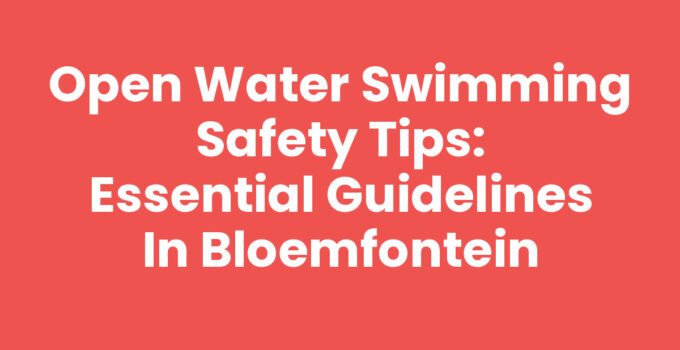Open water swimming is a breathtaking experience, giving you the opportunity to connect with nature and enjoy scenic views while benefiting from an invigorating workout. However, it comes with its own set of challenges and safety considerations. In this guide, we will outline essential open water swimming safety tips specific to Bloemfontein, helping you to make the most of your swimming adventures while ensuring your safety.
Open Water Swimming Safety Tips, Bloemfontein: A Step-by-Step Guide
Open water swimming safety cannot be stressed enough. Here are vital tips and steps to ensure a secure swimming experience in this beautiful city:
1. Check Water Conditions
Before heading out for a swim, always check the water conditions. Monitoring weather reports is critical, as strong winds and storms can create unsafe conditions. Also, assess the water’s temperature, clarity, and current.
2. Choose Safe Locations
Stick to designated swimming areas or monitored lakes that have lifeguards on duty. Bloemfontein boasts several suitable locations, such as the Bloemfontein Dam and Ngwathe River. Always heed local regulations and guidance regarding safe swimming zones.
3. Swim with a Buddy
Never swim alone, regardless of your experience level. Having a buddy with you ensures that help is at hand if anything goes wrong. It also makes the experience more enjoyable and fosters a sense of camaraderie.
4. Wear Appropriate Gear
Use a wetsuit or swimskin for warmth, buoyancy, and visibility. Bright colors help ensure visibility to other swimmers and boats. Also, consider a swim buoy — a flotation device that floats behind you and can be used as a safety rescuer if needed.
5. Know Your Limits
Understand your swimming capabilities and never push beyond your limits, especially in open water where conditions can fluctuate. Be wary of fatigue, and if you’re feeling overwhelmed, signal for help or return to the shore.
6. Familiarize Yourself with the Landscape
Before diving in, take time to familiarize yourself with the surroundings. Be aware of any submerged hazards, rocks, or strong currents. Swimming in known areas helps prevent accidents.
7. Use Sunscreen
Sun protection is often overlooked in open water. Apply waterproof sunscreen to avoid sunburn, especially on areas that are exposed while swimming.
8. Stay Hydrated
Even in the water, it’s essential to keep hydrated. Bring water along to enjoy during breaks, as you can easily become dehydrated while swimming.
9. Emergency Preparedness
Know whom to contact in case of emergencies. Familiarize yourself with emergency contact numbers and have a plan in place for unlikely scenarios like a sudden change in weather or swimming incidents.
Related Guide: Exploring Bird Sanctuaries in Bloemfontein: A Guide for Bird Lovers
Benefits of Open Water Swimming
Beyond safety, open water swimming offers significant benefits, especially in scenic locales like Bloemfontein. Here are some upsides:
- Physical Health: Improves cardiovascular health and builds strength.
- Mental Wellbeing: Reduces stress and enhances mood, thanks to the natural environment.
- Community Interaction: Joining local open water swimming groups fosters camaraderie and new friendships.
Check This: The Best Shooting Ranges in Bloemfontein: Your Ultimate Guide
Conclusion
Embracing the joys of open water swimming in Bloemfontein can be both thrilling and rewarding, provided safety is your top priority. With these open water swimming safety tips, you’re set to explore the beautiful aquatic landscapes with confidence. Prepare thoroughly, swim smart, and enjoy the adventure ahead!
You Might Also Like: What’s on in Bloemfontein for Free: Your Ultimate Guide
Frequently Asked Questions
What should I wear for open water swimming in Bloemfontein?
Wear a wetsuit or bright swimskins for warmth and visibility. A swim buoy is also recommended for safety.
Are there lifeguards at open water swimming spots in Bloemfontein?
Yes, many designated swimming areas like the Bloemfontein Dam have lifeguards on duty to ensure safety.
How do I know if the water conditions are safe?
Check weather reports, assess water clarity, temperature, and currents, and only swim in monitored locations.



